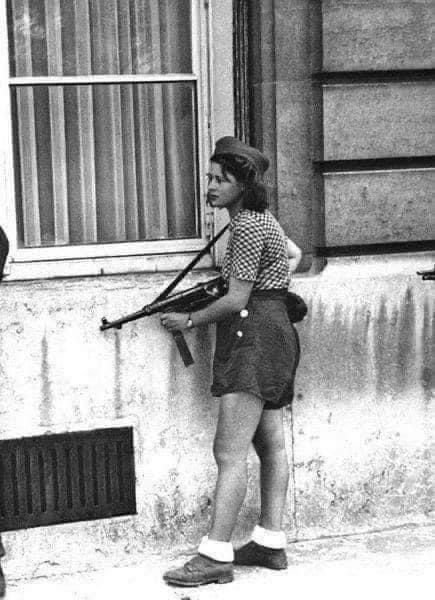Sunday Stir #51 - Speed Training, Badass Women, Toasting, Winston Churchill
Dec 27, 2021 1:01 pm
Happy Sunday, well Monday now. The software I use was under maintenance all day and I couldn't get in to schedule this so I'm sending it today.
I’m launching an online course on speed training for soccer players. In middle school and high school, I spent a lot of time getting faster for soccer. So I thought, hey this is something I know a lot about and have devoted a lot of energy to so I might be able to put this to use and make some money. I’m trying to create some more passive income and my first milestone goal is to make $2,000 a month from it. Once I hit that, the next goal will be $5k. Then $10k. Honestly, I’d be happy to make $500/month from it. I’ll let you know how it goes lol.
Alrighty, on to the Stir!
The World of Badass Women
This is the story of Simone Segouin, mostly known by her codename, Nicole Minet. She was only 18-years-old when the Germans invaded. Her first act of rebellion was to steal a bicycle from a German military administration, and to slice the tires of all of the other bikes and motorcycles so they couldn't pursue her. She found a pocket of the Resistance and joined the fight, using the stolen bike to deliver messages between Resistance groups.
She was an extremely fast learner and quickly became an expert at tactics and explosives. She led teams of Resistance fighters to capture German troops, set traps, and sabotage German equipment. As the war dragged on, her deeds escalated to derailing German trains, blocking roads, blowing up bridges and helping to create a German-free path to help the Allied forces retake France from the inside. She was never caught.
Segouin was present at the liberation of Chartres on August 23, 1944, and then the liberation of Paris two days later. She was promoted to lieutenant and awarded several medals, including the Croix de Guerre. After the war, she studied medicine and became a pediatric nurse. She is still going strong, and this October (2021) she turned 96.
The World of Toasting
Toasting wasn’t always a refined ritual. It was common, up until the Victorian age, for one to drain their vessel completely. This lead, of course, to a lot of excessive drunkenness and the trouble that comes with that. There was even groups of people (mainly women) that were trying to get toasting abolished because of the excessive imbibing taking place. Although anti-toasting crusades gathered steam and some laws and decrees were issued to abolish the practice, toasting’s popularity continued on.
For example, during a dinner in America in 1770 that brought together 45 male friends, no less than 45 toasts were given (presumably one for each man in attendance). In fact, it was during the 18th century that the role of toastmaster was created to function as a sober referee who ensured everyone who wanted to toast got the chance.
During the Victorian age, toasting became more common in mixed company, and simply sipping the drink after a toast replaced the tradition of draining one’s vessel dry. A kind of competitive element to toasting remained, but came to center on the quality of one’s toast, rather than on how much alcohol one could imbibe.
For thousands of years, toasting was in fact a central and exclusive part of men’s classical honor culture. It was a ritual that, if often taken to excess, was animated by the ethos of competition, tested the masculine quality of improvisation, required the risk inherent to performance, and built bonds of brotherly camaraderie.
Toasting not only has a long, storied history, but remains a useful ritual, providing a singular way to express sincere and affectionate sentiments, show off a bit of your personality, bring people together, and make special events even more special.
Why should we bring it back?
Requires risk and courage. If you give a toast, you’ll likely be the only one who does, and thus won’t be compared to anyone else. But it still requires courage to attempt. It’s a mini performance, one that requires facing the chance of achieving great success, or stumbling over what you say. Your toast may bomb or soar — that’s the wonderful, heart-enlivening risk of it!
Requires practicing the art of speaking. Toasting gives you a chance to exercise your chops.
Involves the art of improvisation. Prepare a toast but tweak based on the particular mood of the crowd.
Injects a bit of dramatic anticipation into an event. This always makes an event more memorable and interesting.
Prompts you to share sincere feelings you might otherwise not. We often think of nice things we’d like to say to others, but have a hard time finding an appropriate moment to express them — one in which it won’t sound awkward or out of place. The established ritual of toasting facilitates the sharing of these hard-to-express feelings.
*None of this is original material, I stole all of this info from this post and removed a lot of detail and just gave you the main points. If you want to read more about the history toasting, read it here.
The World of Wisdom
Winston Churchill inspires me. Here’s a few quotes from him:
“It is better to have an ambitious plan than none at all.”
“The price of greatness is responsibility.”
“One must make the best one can of the opportunities of the age.”
“Why do we regard history as of the past and forget we are making it?”
End Note
If you've enjoyed the Sunday Stir, I'd love it if you shared it with a friend or two. You can send them here to sign up. I hope you're enjoyed this episode.
Live free,
Brennen
